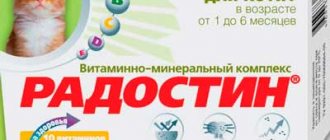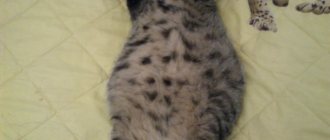5964Pavel
How nice it is to watch a kitten frolic cheerfully, even if at the same time he plays pranks so much that flower pots fly off the shelves. However, a pet can remain cheerful and healthy only by receiving high-quality nutrition that provides a full range of vitamins. Moreover, brewer's yeast plays an important role for cats. Unfortunately, our pets often get sick without any particular reason, and every owner of a delicate cat wonders what causes the appearance and development of a complex illness. The answer is quite banal - lack of vitamins.
What is brewer's yeast
Brewer's yeast is a brown powder obtained from a single-celled fungus. It’s easy to guess that this product is a “by-product”, and it is obtained during the fermentation of wine, beer and dough.
Brewer's yeast is a source of:
- Protein.
- B vitamins.
- Minerals.
In addition, regular, moderate consumption of brewer's yeast maintains metabolic rate and reduces the negative effects of stress on the body.
But my cat feels great eating dry food!
This statement is heard very often. However, the following should be considered:
- Any living creature “looks great” as long as no external signs of disease are visible.
- Any cat with confirmed diabetes was “perfectly healthy” as long as their owners did not notice signs of the disease.
- Every cat with a urinary tract obstruction was “healthy” until it developed urinary problems, died from a ruptured bladder, or had to be rushed to the clinic for emergency catheterization.
- Any cat with bladder inflammation (cystitis) was “healthy” as long as it showed no signs of pain, blood in the urine, or urinating outside the litter box—not due to bad manners, but “for health reasons.”
- All cats are healthy until food containing allergenic ingredients results in signs of food intolerance, inflammatory bowel disease, or asthma.
- Any cat with kidney or bladder stones appears healthy until they reach a size that causes outward signs of disease.
- Even in cats with cancer in the early stages, as long as the tumor is small, there are no noticeable signs of disease.
The fact is that diseases begin long before the cat begins to feel them.
This is why saying that a cat feels well on dry food means little to a veterinarian recommending preventative nutrition.
. Instead of wasting time, nerves and energy on treatment, it is better to avoid the onset of the disease by immediately adopting a diet appropriate for the species. This is a low-carb wet (canned) or balanced homemade food (which, of course, is more difficult), but not dry food.
Of course, when choosing preventative nutrition, a person must understand the following:
- All organs of the urinary system will function better if enough water
. Urinary tract obstruction is commonly observed in cats (especially male cats) fed dry food. This dangerous disease, however, is very rare among cats that eat canned food, especially if water is added to the food. Both cats and cats, with such a diet (rich in water), are much less susceptible to cystitis. - Cats by nature have a low sensitivity to thirst
, so it is necessary to ensure that they consume water with their food.
In nature, a cat's prey consists of approximately 70–75% water; dry food contains only 5–10% water. Cats do not make up for this deficiency from a saucer of water
, as their owners think. Some studies show that wet-fed cats consume twice the amount of fluid compared to dry-fed cats, even when water is constantly available. - Carbohydrates can contribute to sugar-insulin imbalance
, increasing the risk of developing diabetes. Dry food, like some canned food, contains a lot of carbohydrates, some of which can be harmful. Please note that “grain-free” foods are not necessarily low-carbohydrate, as potatoes and peas are often used instead of grains. - Cats are obligate carnivores.
Their body is adapted to obtain protein from meat, and not from grains, peas or potatoes, which are present in large quantities in dry food. - The popular myth that dry food is good for teeth
has no scientific basis. Cats often swallow the pellets whole, but even when chewed, they do not have an abrasive effect, since they are fragile and simply crack. True, canned food also does not have any abrasive effect. In this sense, they are no better (but no worse) for dental health than dry ones. You need to take special care of your teeth, without relying on the effects of food.
Proponents of dry food often say that wet food is too expensive. However, if you take into account the costs of treating diseases that arise from such a diet, the picture changes. Many people reconsider their views after seeing the vet bill. Perhaps it is worth considering the option of feeding canned food as a preventive measure, allowing you to prevent many diseases.
What is the difference between brewer's and nutritional yeast
In terms of properties, these products are similar. Nutritional yeast is specifically grown on sugar cane or beet molasses, but it also comes from a fungus. Unlike brewer's yeast, nutritional yeast is light yellow in color and is considered an absolutely safe product.
Brewer's yeast tastes bitter, and nutritional yeast has a nutty or cheesy taste. Almost 50% of nutritional yeast is protein. Unlike brewer's yeast, nutritional yeast contains a lot of potassium but virtually no sodium.
Naturally, the price also differs. Nutritional yeast is more expensive. If you decide to introduce brewer's yeast into your pet's diet, be sure to read the composition of the powder before purchasing! Many manufacturers add garlic to brewer's yeast, which is toxic to cats.
Contraindications
Despite the benefits, in some cases it is not advisable to prescribe brewer’s yeast (or do so after prior consultation with a veterinarian):
- It is not advisable to give them to kittens under six months of age.
- Despite all the benefits, the supplement is also contraindicated for cats over 11 years of age due to too high amounts of amino acids, which is not very good for the kidneys (and pets at that age will still have problems with them).
- Accordingly, they are contraindicated for kidney disease.
- Yeast should not be given if the animal is allergic to any of its components.
- Although there are no restrictions on feeding pregnant cats, we recommend that you consult a veterinarian before doing so.
Beneficial Side Effects of Yeast
Typically, yeast is introduced into a cat’s diet to compensate for its need for B vitamins. Observations from veterinarians have shown that there are two more beneficial effects:
- Yeast increases appetite, which is very useful for cats who are picky eaters. Yeast is often used at the stage of transitioning a cat from dry to natural food.
- Observations have shown that after 1–2 months, fleas stop attacking the cat. We can say that a cat that consumes yeast becomes unpalatable to parasites.
Characteristics of economy class dry food
From the above it follows that the harmfulness of dry food lies not in its form, but in the imbalance in a number of nutritional components. The raw materials for economy-class dry food are waste from meat processing plants. Coarse grains containing allergens and antinutrients are used as sources of carbohydrates. They are inactivated by extrusion, but not completely. To make the food more attractive, flavorings and taste correctors are added. The following brands are popular in Russia:
- Kitty-Kat.
- Dr. Clouder.
- Whiskas.
- Friscas.
The demand for such food is due to the low purchasing power of the population.
The harmfulness of such foods is established if they are fed to purebred cats. Sterilization makes animals more vulnerable. But such products are popular among owners of outbred felines. Cats fed dry or wet economy-class food live up to 10–15 years, so it is impossible to determine what exactly caused their death.
The most characteristic symptoms of pathologies caused by unbalanced feeds are urolithiasis and allergic manifestations.
Kitty-Kat food
Dangerous Side Effects
Any useful substance that is consumed in excessive quantities can cause poisoning. In addition, yeast contains phosphorus, which is recommended to be minimized in the diet of adults, especially sterilized animals.
A standard dose of yeast for an adult cat contains about 15 mg of phosphorus, and this amount of trace elements is absolutely safe.
Important! Yeast is contraindicated in any dosage if the cat has acute, chronic or progressive renal failure.
Dependence on dry food.
If your cat refuses any food other than dry food, don't stop trying to change the diet.
Any cat can be transitioned to a water-rich, low-carbohydrate diet with enough patience and a little creativity. The consumption of dry food is associated with three main problems:
- Water content too low.
Increases the likelihood of cats developing serious and life-threatening urinary tract diseases. Among them are extremely painful and often fatal (and requiring expensive treatment) such as urethral obstruction. - Too high carbohydrate content.
Causes a predisposition to diabetes, obesity and intestinal diseases. Note that low-carb dry foods are also not considered healthy foods because they contain little moisture and lose nutrients when cooked during manufacturing. - The content of plant proteins is too high
relative to animal proteins. Cats are obligate carnivores, their bodies are adapted to eating meat. Herbal components are needed only to increase the profits of manufacturers and do not contribute to the preservation of cat health.
Among other problems:
- bacterial infection (can cause vomiting and diarrhea);
- fungal mycotoxicoses (due to fungi contained in cereal grains that produce extremely toxic substances);
- insects and their feces (can cause breathing problems);
- ingredients that often cause allergic reactions;
- lack of nutrients due to their loss during the production of feed;
How to choose brewer's yeast for a cat
Brewer's yeast is manufactured and sold within the food industry. Yeast qualifies as a food additive and is most often sold in powder form. The advantages of choosing are low cost, the minus is the inconvenience of dosage.
Brewer's yeast is produced by almost all manufacturers of animal feed and vitamins. Often the additive is also produced at enterprises that produce products for people - a by-product.
Veterinary brewer's yeast can be produced in pure form or with additives:
- Sulfur.
- Calcium.
- Succinic acid.
- Taurine.
- Zinc.
- Sea kale.
- Mumiyo, etc.
Note! Taurine is an important and rare amino acid that is vital for cats. With a lack of taurine, heart failure and metabolic disorders develop.
Some examples of veterinary yeast supplements:
- 8in1 Excel Brewers Yeast.
- AVZ dry yeast (tablets).
- Beaphar Brewers Yeast With Garlic.
- Trixie Brewer`s Yeast.
- Brewer's yeast with seaweed ZOOMIR.
Release form, composition and packaging
Pills
from light gray to dark gray in color with inclusions, biconvex, with a notch on one side, with a peculiar smell; with an average weight of 0.4 g with a diameter of 9.9-10.2 mm (for dogs and cats) and 2.1 g with a diameter of 19.8-23 mm (for large dog breeds).
| 1 tab. | |
| brewer's yeast (Saccharomyces cerevisiae) | 91% |
| garlic | 1.2% |
| oils and fats (glycerin, 0.8% tuna oil, stearic acid, safflower oil) | 6.9% |
Excipients
: silicon dioxide - 0.9%.
Does not contain genetically modified products.
1 tablet contains:
| Components | In a tablet weighing 0.4 g | In a tablet weighing 2.1 g |
| Crude protein, not less than % | 43 | 43 |
| Crude fat,% | 7 | 7 |
| Crude fiber,% | 1 | 1 |
| Moisture,% | 8 | 8 |
| Vitamin B1, mg | 0.32 | 1.68 |
| Vitamin B2, mg | 0.2 | 1.05 |
| Vitamin B6, mg | 0.024 | 0.126 |
| Niacin, mg | 0.48 | 2.52 |
| Iron, mg | 0.77 | 4.02 |
| Biotin, mcg | 0.76 | 4 |
| Copper, mg | 0.001 | 0.005 |
| Manganese, mg | 0.13 | 0.7 |
| Zinc, mg | 1.31 | 6.87 |
| Cobalt, mg | 0.045 | 0.24 |
Permissible deviations in the content of components from those specified in the recipe should be: for microelements - no more than 10%, for vitamins - no more than 15%. The content of harmful impurities does not exceed the maximum permissible standards in force in the Russian Federation.
Packaged in 80, 140, 260, 780 and 1430 pcs. in polymer jars of appropriate capacity with screw caps.
Each package is labeled in Russian indicating: the name of the manufacturing organization, its address and trademark, name, purpose and method of use of the additive, composition and guaranteed indicators, shelf life and conditions, batch number, tablet weight, number of tablets in the package, date manufacturing, information about certification, the inscription “For animals” and provide instructions for use.
Immune organs
After we have examined the concept of immunity and its main types, it is necessary to pay attention to the organs that provide it.
There are central and peripheral organs of the immune system.
The central ones include:
- Red bone marrow. Found in bones. Serves as a source of formation of all blood cells, including cells of the immune system.
- Thymus. It further matures some of the immune system cells coming from the red bone marrow.
Peripheral organs:
- Lymph nodes.
- Spleen.
- Accumulations of lymphoid cells in the skin, respiratory organs, and intestines.
Features of the formation of immunity in children
The formation of immunity in children has its own characteristics depending on age.
A feature of the formation of the immune system in children is the presence of so-called “ critical ” periods:
- The first critical period after the birth of a baby is the neonatal period. At this time, the baby encounters a huge number of pathogens. The immune system during this period is subject to strong immunosuppressive effects. This period is characterized by low resistance to many infections. There is a tendency to develop common infections.
- The second period occurs at the age of 3-6 months. It is characterized by a weakening of immune reactions due to the destruction of antibodies that were transmitted from the mother.
- The third period develops in the second year of life. During this period, the baby's contact with the outside world increases significantly. At this age, many abnormalities of the immune system appear, as well as autoimmune (directed against one’s own body) diseases. Children are prone to repeated acute respiratory infections.
- The fourth period occurs in the 4th-6th years of life. This period is characterized by a high prevalence of allergic and parasitic diseases. During this period, many chronic diseases develop.
- The fifth period occurs during adolescence. For girls this corresponds to 12-13 years old, for boys - from 14-15 years old. A large growth spurt is accompanied by a decrease in the mass of lymphoid (immune) organs. An increase in the formation of male sex hormones leads to a decrease in the cellular component of immunity. In this regard, many allergic diseases are weakened. The influence of the external environment on the development of immunity is increasing. At this time, there is a new rise in the incidence of chronic inflammatory, autoimmune, and viral diseases.
The processes of formation of the immune system in children can slow down under the influence of various external factors:
- Xenobiotics (chemicals).
- Intrauterine infections
- Frequent ARVI and digestive tract infections.
- The influence of environmental environmental factors and many others.
Some external factors can slow down the development of the immune system in children.
These factors, which slow down the formation of the immune system in children, lead to functional immaturity of the immune system and, accordingly, predispose them to the development of immunodeficiency states (a state of reduced immunity).











